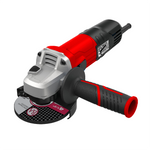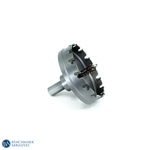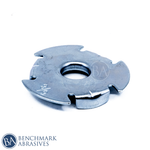
How to Get the Most Out of Your Flap Disc

Choosing the proper disposable flap disc reduces the chance of removing too much material and assures an optimal finish for a given grinding, blending, or finishing task. Here are a few important considerations to consider while selecting the best instrument for the job to maximize flap disc effectiveness and longevity.
Using the appropriate equipment can save time and money for metal grinding or finishing tasks. The greatest option can reduce the chance of eliminating too much material and provide the best finish. Flap discs allow fine blending and finishing operations while providing dependable grinding action. Because of these characteristics, they are a flexible and effective option for many applications, even those utilizing thinner materials.
Flap discs use the same grain types as bonded abrasive cutting, grinding, and combination wheels, but their layered flap design gives them a softer, more forgiving feel. Because of this, flap discs can be used for grinding and finishing without switching to another product or disc. There are several important factors to think about to selecting the best flap disc for the job and maximizing product efficacy and longevity:
- What kind of substance is being worked on?
- What are the demands for a surface finish and the ideal appearance of the finished piece?
- Are there requirements for the task regarding time, output, and efficiency?
- What are the associated labor and supply costs?
Basics Of Flap Disc
Flap discs use coated abrasives that hold grains to a backing fabric. The fabric, frequently cotton, polyester, or a combination, is then divided into smaller flaps and stacked to create the flap disc. The flaps wear away as the grains exhaust and lose their cutting effectiveness, revealing new, acute grains underneath. Flap discs can be used effectively until the cloth is almost worn all the way to the back plate. For use on right-angle grinders at angles ranging from 5 degrees to 35 degrees, flap discs are intended.
Flat-profiled Type 27 flap discs are ideal for finishing and applications that call for lower grinding angles, such as 5 to 15 degrees. Type 29 flap discs, with a slight slant, are suitable for more vigorous, higher-angle grinding. Since a flap disc's fabric can catch or tear in these really intense grinding situations, hard grinding discs may be preferable when the work requires more aggressive action or grinding on rougher surfaces.
Grain Options And Disc Size
Consider the specifications of the finished weld while selecting the right grain for the operation. Keep in mind that the coarser and more aggressive the grit, the lower the number. Larger grit sizes are less abrasive and finer and offer better finishes. To get the greatest finish, use the highest grit while still getting the job done. Flap discs are also offered in high-density and standard-density varieties.
The disc size options range from 2 into 7 in, and 2 in and 3 in flap discs can frequently replace a blending disc and provide up to 15 times the use, reducing the number of product changeovers, increasing productivity, and significantly lowering the overall cost of use. High-density, durable flap discs are great for grinding on curved or irregular surfaces.
Selection Of The Abrasive Material
The type and grit size of the abrasive substance employed significantly impacts the disc's performance. Aluminum oxide, zirconia alumina, and ceramic alumina are the main grains used. The objective is to identify the flap disc that completes the application's requirements within the desired schedule and budget. Aluminum oxide is a reliable, affordable product alternative, although zirconia alumina flap discs frequently provide the greatest adaptability for the least amount of money spent. Zirconia alumina flap discs are the most widely utilized flap discs nowadays.
Zirconia alumina flap discs come in different quality levels. Combining zirconia alumina and aluminum oxide grains is one less expensive approach. 100% zirconia alumina grains are another high-performance option. These discs don't degrade as quickly and keep their cut rate longer. Aluminum oxide flap discs are slightly more expensive than standard and high-performance items up front, but they have better heat resistance, toughness, and durability.
High-performance flap discs should be kept in mind as they are more expensive. Still, they can offer a much reduced overall use cost by minimizing changeovers, reducing downtime, and enhancing productivity. Ceramic alumina, the most expensive but most durable and heat-resistant abrasive, is a third alternative. The grains in these flap discs are made to break apart and produce fresh, sharp edges. Ceramic flap discs last longer while maintaining their sharpness and cut-rate. Ceramic flap discs are more expensive up front, but when other factors are considered, they frequently offer a lower overall use cost. They are the ideal option for grinding tougher materials like stainless, Inconel, titanium, armored, and tool steels.
Maintenance Practices To Increase Flap Disc Lifespan
Maximizing disc efficiency and lifetime requires proper technique. If excessive pressure is applied, a flap disc may prematurely wear down or develop gouging, undercutting, heat buildup, and color fading. A disc with coarse grit or a different disc may be needed if you need to exert more force to get it to work.
Excessive pressure might harm the workpiece and raise safety and health issues. Let the disc handle the work to reduce the danger of stress-related injuries. Use a strong tool to maintain its rotational speed when utilizing premium cutting grains, such as ceramic alumina. The ability of the grain to fracture and self-sharpen is decreased when the pressure is too much because a weak grinder can "bog down" under strain.
For best performance, flap discs are created such that the entire width of the flap is utilized. Because they are not utilizing the entire breadth of the cloth while grinding at an excessively steep angle, the operator and the disc must work significantly harder. Due to the increased tension on the flap, this can also shorten the device's lifespan. An operator will frequently toss away a disc when the flap's edge prematurely wears, wasting a significant amount of the disc's abrasive material and value. Users who utilize Type 27 (flat) discs and grind at greater angles are likelier to experience this.
The full width of the flap can frequently be employed throughout the grinding operation by simply switching to a Type 29 (conical) disc, maximizing efficiency and minimizing disc use. Avoiding excessive metal removal while finishing thin material is especially crucial because doing so could result in a weak spot. This can be avoided by choosing the least aggressive disc that can nevertheless do the task, especially when tight tolerances are necessary.
It is recommended to start with a higher grit - 60 or 80 - then proceed down as necessary if more aggression is needed, if there is a worry about removing too much material too rapidly, or if a certain finish is wanted. Flap discs are intended to be used until adhesive is visible through the flap. A disc will keep cutting when used properly until the adhesive is apparent. This advice can result in significant annual product cost savings.
Flap discs are disposable tools, but some procedures may be performed to increase their lifespan and usefulness. It's crucial to remember that various alternatives and settings are created to increase productivity, decrease downtime, and offer higher cost savings. For advice tailored to your needs, speak with the distributor representative or manufacturer in your area.
Additional Tips
-
Ensure to use of high-quality abrasive disc material for better performance and greater lifespan. High-quality or premium material offers exceptional cutting results with a more stable and fine finish and is highly durable. Some of the premium materials include ceramic, silicon carbide, and zirconia alumina.
-
Invest in a high-quality angle grinder that reduces vibrations and maintains a consistent speed. This results in clean and accurate cuts while providing better control over the workpiece during the cutting process.
-
Wear protective gear to prevent severe injuries or accidents. This is the most important safety tip to consider. It includes shields, face masks, gloves, helmets, etc.
By following the above tips, you can easily achieve success in using an angle grinder and also ensure its safety and durability.



































































